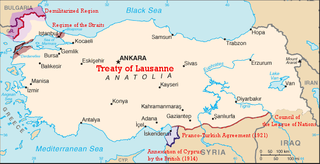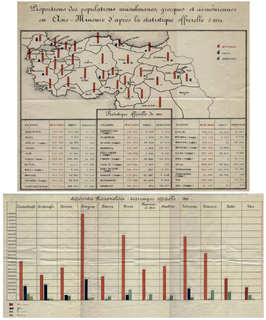 W
WThe 11 September 1922 Revolution was an uprising by the Greek army and navy against the government in Athens. The revolution took place on 11 September [N.S. 24 September] 1922.
 W
WConcluded on 30 October 1918 and taking effect at noon the next day, the Armistice of Mudros ended hostilities in the Middle Eastern theatre between the Ottoman Empire and the Allies of World War I. It was signed by the Ottoman Minister of Marine Affairs Rauf Bey and British Admiral Somerset Arthur Gough-Calthorpe, on board HMS Agamemnon in Moudros harbor on the Greek island of Lemnos.
 W
WThe great fire of Smyrna or the catastrophe of Smyrna destroyed much of the port city of Smyrna in September 1922. Eyewitness reports state that the fire began on 13 September 1922 and lasted until it was largely extinguished on 22 September. It began four days after the Turkish military captured the city on 9 September, effectively ending the Greco-Turkish War, more than three years after the Greek army had landed troops at Smyrna on 15 May 1919. Estimated Greek and Armenian deaths resulting from the fire range from 10,000 to 100,000.
 W
WThe Greek genocide, including the Pontic genocide, was the systematic killing of the Christian Ottoman Greek population carried out in Anatolia during World War I and its aftermath (1914–1922) on the basis of their religion and ethnicity. It was instigated by the government of the Ottoman Empire and the Turkish national movement against the indigenous Greek population of the Empire and included massacres, forced deportations involving death marches, summary expulsions, arbitrary execution, and the destruction of Eastern Orthodox cultural, historical, and religious monuments. According to various sources, several hundred thousand Ottoman Greeks died during this period. Most of the refugees and survivors fled to Greece. Some, especially those in Eastern provinces, took refuge in the neighbouring Russian Empire.
 W
WThe Treaty of Lausanne was a peace treaty negotiated during the Lausanne Conference of 1922–23 and signed in the Palais de Rumine, Lausanne, Switzerland, on 24 July 1923. It officially settled the conflict that had originally existed between the Ottoman Empire and the Allied French Republic, British Empire, Kingdom of Italy, Empire of Japan, Kingdom of Greece, and the Kingdom of Romania since the onset of World War I. The original text of the treaty is in French. It was the result of a second attempt at peace after the failed Treaty of Sèvres. The earlier treaty had been signed in 1920, but later rejected by the Turkish national movement who fought against its terms. The Treaty of Lausanne ended the conflict and defined the borders of the modern Turkish Republic. In the treaty, Turkey gave up all claims to the remainder of the Ottoman Empire and in return the Allies recognized Turkish sovereignty within its new borders. It provided for the Greek-Turkish population exchange and allowed unrestricted civilian passage through the Turkish Straits.
 W
WThe 1923 population exchange between Greece and Turkey stemmed from the "Convention Concerning the Exchange of Greek and Turkish Populations" signed at Lausanne, Switzerland, on 30 January 1923, by the governments of Greece and Turkey. It involved at least 1.6 million people, most of whom were forcibly made refugees and de jure denaturalized from their homelands.
 W
WThe Trial of the Six or the Execution of the Six was the trial for treason, in late 1922, of the anti-venizelists officials held responsible for the Greek military defeat in Asia Minor. The trial culminated in the death sentence and execution of six of the nine defendants.